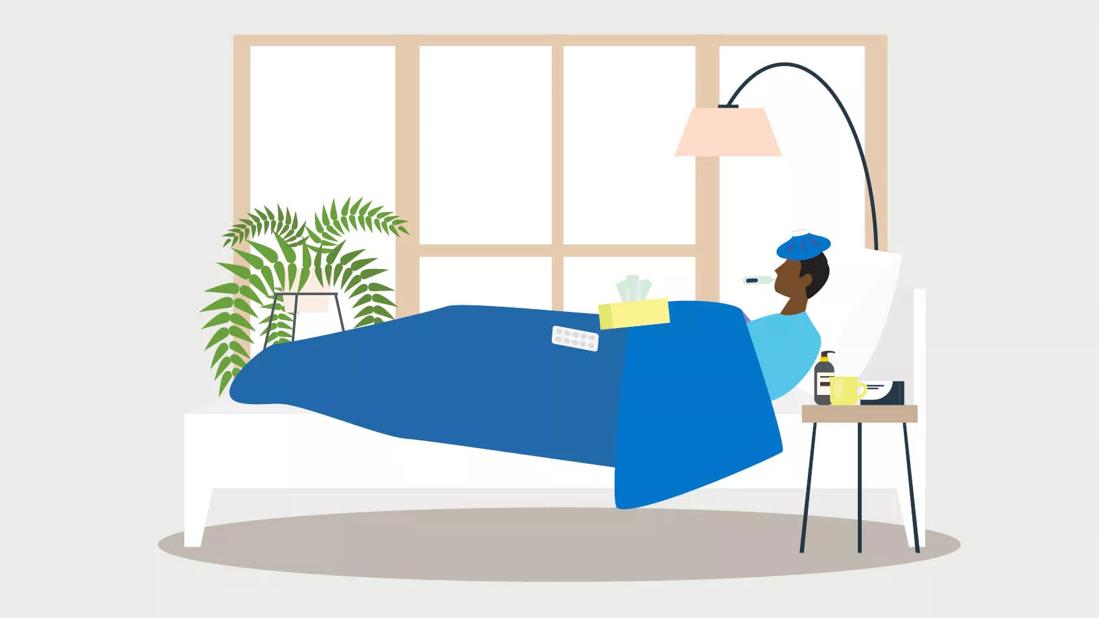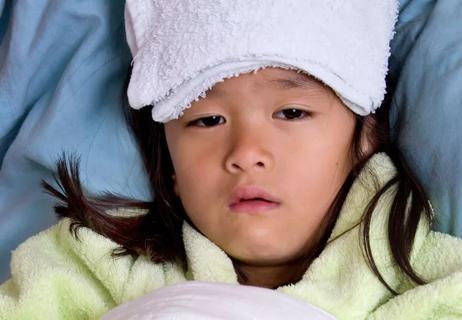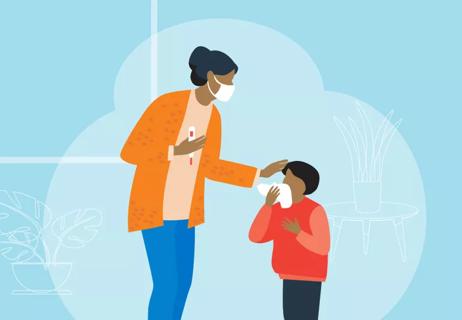Get some rest, drink fluids, use blankets or ice packs and take medications

Fevers make you feel terrible. You might have body aches and fatigue, or maybe you’re caring for a child that’s sick and restless. Whether it’s you or your child, spiking a fever sets you up for hours — or sometimes days — of misery.
Advertisement
Cleveland Clinic is a non-profit academic medical center. Advertising on our site helps support our mission. We do not endorse non-Cleveland Clinic products or services. Policy
Do you have to wait for a fever to “run its course”? Or can you do anything to break it faster? Whether you’re checking your child’s temperature and you’re concerned about their fever, or you’ve got a fever of your own, Neha Vyas, MD, family medicine physician, explains how to break a fever and get you feeling better in no time.
You can break a fever by getting plenty of rest, drinking fluids, using blankets if you have shivers or an ice pack if you’re too hot, and by taking medications like acetaminophen or ibuprofen. But in most cases, you don’t necessarily have to break a fever. They often handle themselves especially if you feel okay and have a mild illness.
In children, it’s a common myth that fevers often cause seizures and brain damage. Febrile seizures can happen in up to 5% of kids under 5 years old, but there’s no evidence that they cause brain damage.
Sill, lowering a fever may provide you with some much-needed relief. It could be enough to help you get some sleep or to settle a sick child. If you want to break a fever faster, these tips can help:
Resist the urge to tackle your to-do list when you have a fever. “Your immune system needs rest to work properly,” says Dr. Vyas. “Stay home from work or school and lie down whenever you can. If you try to do too much, your fever and illness could last longer.”
Advertisement
Sleep if you can. If you can’t sleep, curl up with a good book or listen to a podcast or audiobook instead.
Hydration could help your illness — and fever — hit the road as quickly as possible. You’ll likely sweat more when you have a fever, and you need to replenish those fluids by drinking. Plus, every system in your body — including your immune system — needs fluids to function at its best.
“You can quickly get dehydrated if you’re not drinking during a fever,” says Dr. Vyas. “And when you’re dehydrated, it’s harder for your body to fight off an illness.”
Drink what sounds good to you, such as water, herbal tea or maybe the occasional sports drink. But steer clear of caffeine, whether from soda, tea, coffee or energy drinks. Caffeine makes you pee more, which could dehydrate you and interfere with your recovery.
And try to eat something, too, as that old adage about “starving a fever” isn’t quite accurate.
If you’re burning up, you don’t have to push through it. You can cool yourself or a child safely with a few home remedies:
“Skip the cooling methods if the fever is causing chills,” says Dr. Vyas. “You or your child will likely feel worse, and that won’t help you relax and heal.”
Cuddle up with a blanket if you can’t stop shivering, but don’t pile on every quilt in the house.
“The old advice to ‘sweat it out’ doesn’t help and could be harmful,” says Dr. Vyas. “Too many blankets could raise your body temperature even more. Heating yourself up could also raise your risk of dehydration because you’ll likely start sweating.”
If you’re cold, get under your normal covers in bed, or throw a blanket around your shoulders. If you start to sweat or feel too hot, take them off.
And be careful about bundling up a baby. Their bodies can’t regulate their temperature as well as older children and adults. Focus on keeping your baby comfortable, not hot.
Nonsteroidal anti-inflammatory drugs (NSAIDs) like acetaminophen and ibuprofen can lower a fever and treat headaches or body aches. Before you take any medicine or give it to your child:
Aspirin can also lower a fever, but don’t give it to children under 18. Giving aspirin to children can cause Reye’s syndrome, a severe and potentially life-threatening condition.
Advertisement
Don’t use medications to lower your temperature just so you can head to work or send your kids back to school. In most cases, illnesses are still contagious for at least 24 hours after your fever breaks naturally without using medications. You could get everyone around you sick — and you’ll probably wear yourself out, which will likely make your fever last longer.
Kids get fevers more often than adults, but fevers affect people of all ages. Regardless of your age, a fever is a sign that something else is going on — it’s not a disease itself.
“Fevers have similar causes in adults and children, such as viruses and infections,” says Dr. Vyas. “But we are more careful about fevers in babies. A baby can’t tell you how they’re feeling, so it’s harder to know what’s causing the fever. If you don’t know what’s ailing your child, call your pediatrician.”
While most fevers aren’t a reason to panic, there are some fevers you shouldn’t ignore. Contact your provider about any fever that:
You should also seek medical care for any fever with symptoms like:
Advertisement
It can be hard to spot these symptoms if your baby or child has a fever. You should also contact your child’s provider if your child is:
Fevers are a part of life, and it’s especially hard when your little one is suffering through one. But take heart: Most fevers see themselves out after a couple of days. Keep a close eye on symptoms and give yourself or your child some TLC until it’s gone. And if you are immunocompromised or have ongoing health conditions, call your provider if you develop a fever.
“If you’re unsure about a fever — maybe you’re worried that it’s not just a mild illness — contact your provider,” says Dr. Vyas. “It’s better to ask and get proper medical advice than to wait and worry. Your provider is here to help, so don’t be afraid to reach out if you’re concerned.”
Advertisement
Learn more about our editorial process.
Advertisement

When your body is fighting infection, your internal temperature rises as a defensive response

Most cases are mild and can be treated at home, but some situations may require medical care or a trip to the ER

It can cause alcohol poisoning and other serious health issues, especially in kids

It’s important not to give them fever-reducing medications right off the bat

What you need to know about these common misconceptions

When undergoing cancer treatment, fever is a critical symptom to address

These red, raised bites often show up in a zigzag pattern on areas of your skin that come into contact with bedding

If you’re feeling short of breath, sleep can be tough — propping yourself up or sleeping on your side may help

If you fear the unknown or find yourself needing reassurance often, you may identify with this attachment style

If you’re looking to boost your gut health, it’s better to get fiber from whole foods